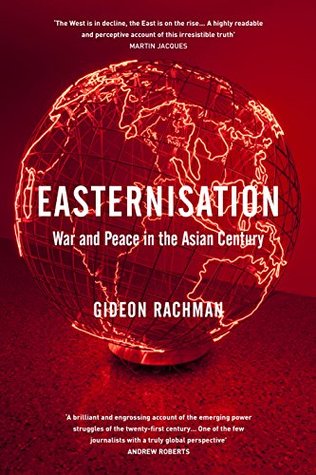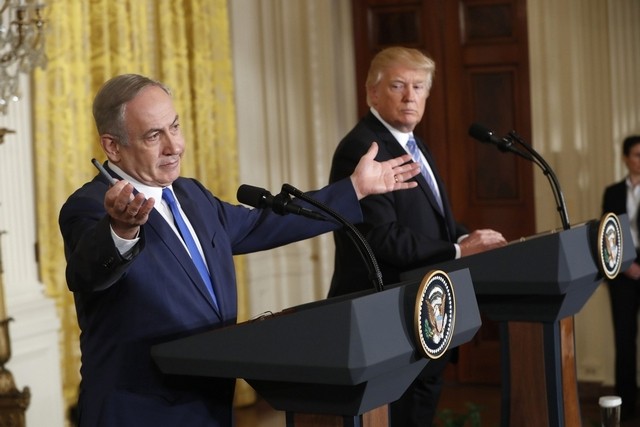Easternization – Asia’s Rise and America’s Decline – From Obama to Trump and Beyond
Book Review of 'Easternisation: War and Peace in the Asian Century' by Gideon Rachman

While this book is not authored by a U.S. educated citizen, its arguments tend to have some of the same problems as the natural born authors have in arguing the case for a continued U.S. presence in world affairs. Rachman presents a reasonable effort in presenting his case for Easternization and this would be a good beginning work for those entering into discussions of global affairs.
Rachman’s perspective is broad, his writing engaging with many personal anecdotes. Considered with the many other writers on U.S. foreign affairs, he is not quite capable of connecting all the dots, even though his ‘dots’ cover a strong range of issues.
The largest factor – not surprising for an author writing for major financial publishers – is the economic factor, and it also an unfortunate over riding miss. The miss is narrow, but still not on target, the target being the military-industrial -financial complex. The components are discussed separately, with frequent connections, but the underlying base to U.S. supremacy in the world is not revealed accurately.

Rachman (image on the right, source: CSIS) begins the work honestly, saying he has “a largely positive view of the role of American power in the world” with the West providing “a pole of stability and power imposing order on a chaotic world.” He sees a multi polar world that needs “a dominant power in the background” to “enforce…the rule of law.” Fair enough – so far. But very quickly Rachman undermines what could have been a much stronger thesis when words about imposing power, a chaotic world, and dominant power imply something more severe than economic control.
It starts with a comment that
“At the beginning of the 1400s, China and the Islamic world were at levels of economic and political power and sophistication that were at least equivalent to those attained in Europe.”
I find that a highly arguable proposition as Europe had just suffered through the Black Death, the culmination of centuries of medieval feudal warfare and ignorance. It was during the Renaissance of the 1400s when Europe strengthened on the knowledge base offered by China and the Arabic nations of the day.
The next steps historically are the voyages of “discovery” and “exploration” by the European empires striving for resources, markets, and wealth. Except that the rest of the world more or less knew where it was, and the doctrine of “discovery” as elucidated by the Christian church was one of civilizing the savage beasts, or eliminating them if they got in the way. A reading of Jared Diamond’s Guns, Germs,and Steel indicates that European dominance started and continued with its superiority in the application of military violence in order to harvest the wealth of the world. It also was and is supported by the same doctrine of discovery with its attitudes towards people of ‘colour’. In other words, military first, economic power later.
In Easternization, Rachman posits the opposite sequence, he says after his brief overview of history,
“These centuries of European and American dominance were based on economic might….It is economic might that allows nations to generate the military, diplomatic, and technological resources that translate into international political power.”
Yes, he accepts U.S.military might, but only as it follows from economic power. Through his own arguments the military is always there, Thomas Friedman’s “hidden fist” that allows for the economic and political dominance to continue.
His argument is also contradictory as many of his points discuss the military imposition of power – on China after the Opium Wars (opium is definitely an economic factor) and the “opening” up of Japan after Perry’s gunboat diplomacy. Currently, America relies “on military force as the basis of its foreign policy in the Pacific.” While discussing Singapore, Rachman notes that the original Muslim kingdom “was overthrown by a Portuguese invasion.”
The line about economic power is reiterated in slightly different forms throughout the book. But it is always backed up by military power as per Friedman. That is the real miss that colours the interpretation of Easternization.
The second miss is being able to connect all the dots. Rachman starts off commenting about a “chaotic” world, and continues on through to the current “dark, violent, and anarchic” situation in the Middle East. He provides an interesting discussion of the “institutions” that control the world economic order, the Bretton Woods arrangements of the IMF, World Bank, et al. That latter of course is a focal point of the “rule of law”, but that in sequence does not discuss the current “rule of law” being highly arbitrary as applied by the U.S. using its military to back it up in its own interpretation or denial of international law, or being highly restrictive in favour of corporations when it comes to corporate trade laws under the rubric of supposed “free” trade.
US president Donald Trump and Israeli prime minister Benjamin Netanyahu
Another dot missed is Israel. It is discussed but not to the degree that shows its use of military force combined with the U.S. military to maintain its position in the Middle East, either domestically against the Palestinians or with the its neighbouring countries. Russia is also discussed disparagingly (and erroneously with respect to the language and ‘facts’ used to support the discussion), but not once are CIA/NATO/NSA/NGO intrigues mentioned in this or any other situation around the world.
A truly clear examination of historical and current events underscores the violent nature of European and U.S. imperial adventures around the world. The military continually imposes its might throughout the period of western economic domination, either directly with aggressive wars (including the U.S. civil war and Indian wars, the Boer War, WW I being essentially a war between European empires, and WWII being the final European imperial battle due to a failed peace process at Versailles), or indirectly through subversion, threats, coercion, and yes, the power of the US petrodollar as reserve currency.
Combine all those dots and near misses and a reader with a broader background would be able to see the real reason for the “chaotic” world and the “dark, violent, and anarchic” situation in the Middle East. Within the current global structures, if the U.S. loses its reserve currency status, or simply becomes one among equals, the US petrodollar would be in danger of collapse.
The current support for Saudi Arabia is not about oil per se, but about oil being marketed using US$ as that is the only thing supporting the US$ at the moment. The enormous debts internally and externally cannot be paid off without some form of massive inflation – or collapse. It is not about terrorists (well, maybe now it is, but they were created/supported in order to help the U.S. contain or defeat its economic threats), nor is it about oil, it is all about attempting to maintain an economic position that after WW II was readily maintained through military force backing up centralized economic control.
It is not about human rights, democracy, or freedom – never has been. China, backed by Russia, is the greatest threat to the continuing role of the US$ as the dominant standard. Easternization presents some interesting details and anecdotes around this central idea, but it fails to connect the dots between military might first, this supporting economic dominance, then the duo used to try and impose U.S.hegemony around the world.
Featured image: Goodreads


